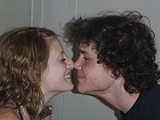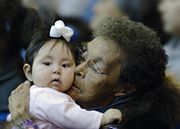
Eskimo kissing
Encyclopedia

Inuit
The Inuit are a group of culturally similar indigenous peoples inhabiting the Arctic regions of Canada , Denmark , Russia and the United States . Inuit means “the people” in the Inuktitut language...
greeting called a kunik.
A kunik is a form of expressing affection, usually between family members and loved ones, that involves pressing the nose and upper lip against the skin (commonly the cheeks or forehead) and breathing in, causing the loved one's skin or hair to be suctioned against the nose and upper lip. A common misconception is that the practice arose so that Inuit could kiss without their mouths freezing together. In fact, it is a non-erotic form of greeting that serves as an intimate way of greeting one another for people who, when they meet, often have little except their nose and eyes exposed.
When early explorers of the Arctic first witnessed this behavior they dubbed it Eskimo kissing. In its western form it consists of two people rubbing noses together. One of the earliest representations of the Eskimo kiss comes from Robert Flaherty's 1922 film Nanook of the North
Nanook of the North
Nanook of the North is a 1922 silent documentary film by Robert J. Flaherty. In the tradition of what would later be called salvage ethnography, Flaherty captured the struggles of the Inuk Nanook and his family in the Canadian arctic...
, considered by many to be the first real documentary or ethnographic film. It is possibly from this source that the non-Inuit/Eskimo public became aware of this convention.
Similar traits are shown in greetings of other people, notably the hongi
Hongi
A hongi is a traditional Māori greeting in New Zealand. It is done by pressing one's nose and forehead to another person at an encounter....
and honi
Hongi
A hongi is a traditional Māori greeting in New Zealand. It is done by pressing one's nose and forehead to another person at an encounter....
greeting used by the Māori of New Zealand
New Zealand
New Zealand is an island country in the south-western Pacific Ocean comprising two main landmasses and numerous smaller islands. The country is situated some east of Australia across the Tasman Sea, and roughly south of the Pacific island nations of New Caledonia, Fiji, and Tonga...
and Hawaii
Hawaii
Hawaii is the newest of the 50 U.S. states , and is the only U.S. state made up entirely of islands. It is the northernmost island group in Polynesia, occupying most of an archipelago in the central Pacific Ocean, southwest of the continental United States, southeast of Japan, and northeast of...
ans respectively, and by Mongolian nomads of the Gobi desert, as well as certain Southeast Asian cultures such as Cambodians, Laotians, Thai, and Ibans.
Scenes involving Eskimo kissing are included in countless media, including episodes of The Simpsons
The Simpsons
The Simpsons is an American animated sitcom created by Matt Groening for the Fox Broadcasting Company. The series is a satirical parody of a middle class American lifestyle epitomized by its family of the same name, which consists of Homer, Marge, Bart, Lisa and Maggie...
, and in a Chappelle's Show
Chappelle's Show
Chappelle's Show is an American sketch comedy television series created by comedian Dave Chappelle and Neal Brennan, with Chappelle hosting the show as well as starring in various skits. Chappelle, Brennan and Michele Armour were the show's executive producers. The series premiered on January 22,...
sketch
Sketch comedy
A sketch comedy consists of a series of short comedy scenes or vignettes, called "sketches," commonly between one and ten minutes long. Such sketches are performed by a group of comic actors or comedians, either on stage or through an audio and/or visual medium such as broadcasting...
in which Eskimo kissing is portrayed as a stereotypically white gesture.

